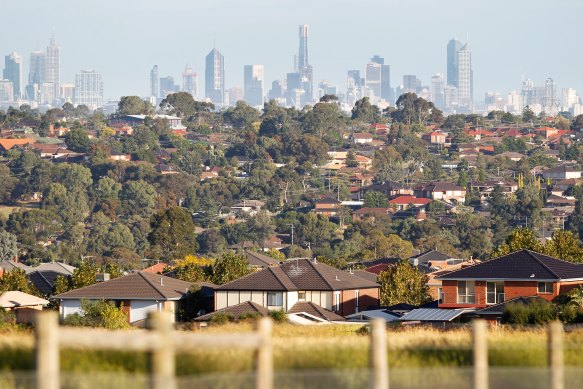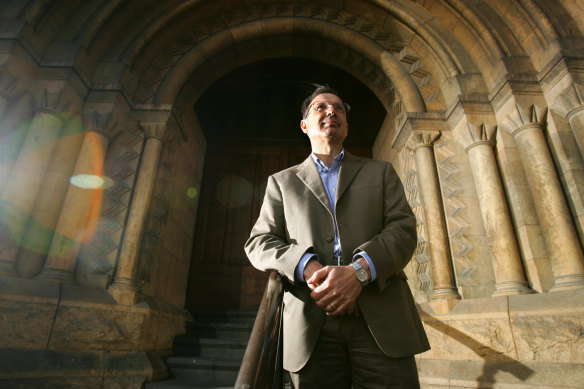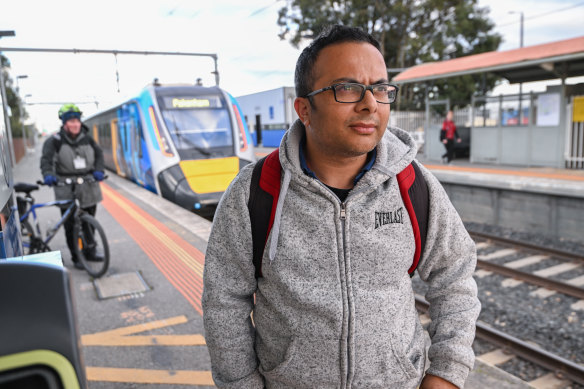
Save articles for later
Add articles to your saved list and come back to them any time.
A prominent planning firm says the Andrews government should decentralise public service jobs by putting offices in Melbourne’s outer suburbs, warning of increasing inequality on the city’s fringe without investment in key infrastructure.
A new report by SGS Economic & Planning has warned that population growth in fringe suburbs will continue to surge, but the lack of professional jobs in these areas will keep many trapped in low-paid industries or in grinding commutes on congested highways and public transport.
Decentralising city-based jobs is also key to curbing urban sprawl, according to a new report.Credit: Paul Rovere
Victoria has failed to meet its long-term target of directing 70 per cent of new housing growth in Melbourne’s inner and middle suburbs, with just 56 per cent of new dwellings in established areas and the rest in greenfield.
Victoria’s peak infrastructure body, Infrastructure Victoria, warned this trend is unsustainable due to the cost of building new roads, schools, public transport and other essentials in greenfield areas.
Premier Daniel Andrews has foreshadowed a package of housing and planning announcements in September that would drag the city back to the target of 70 per cent of homes built in established Melbourne and only 30 per cent on the fringe.
But the new report from SGS warns the curbing of growth on the fringe under the 70/30 model would be “modest”.
The housing target would account for just six per cent less growth in the greenfield areas by 2036, compared with allowing sprawl to continue unabated. This equates to a difference of 200,000 people but would increase over time.
Founding partner at SGS Economics & Planning, Dr Marcus Spiller.Credit: James Davies
SGS partner Dr Marcus Spiller forecasts that 1 million people — or 400,000 households — will still move into growth suburbs over the next three decades under the 70/30 model.
Without any decentralisation, those million people would be moving into the areas with the lowest density of jobs, and the “time had come” for the government to dictate where jobs are located in the state, Spiller warned.
“We used to be a bit fearful of decentralisation, but COVID has changed that,” he said, adding that many businesses proved they weren’t reliant on workers needing to be in the CBD full-time, and that suburban offices could work.
The firm modelled a 30-year scenario whereby all new jobs in the public service would be located in a number of key suburban areas, rather than the city centre.
This would pump 77,500 jobs into areas like Wyndham and Sunshine in Melbourne’s west and Monash and Frankston in Melbourne’s south-east, and boost associated retail, hospitality and businesses.
This scenario, when coupled with a major lift in bus services, has the potential to boost the city’s GDP by 2 per cent.
Prashant Choudhary, a 38-year-old data analyst who lives in the greenfield suburb of Officer, near Pakenham, said he would happily work in a firm closer to home if a similar role existed, but most jobs in his field were based in the CBD.
Choudhary was able to move from a two-bedroom apartment in Southbank to a three-bedroom house in Officer because his workplace remained flexible post-pandemic, allowing him to work from home up to four days a week.
Prashant Choudhary arrives at Officer station on his way home from work in the CBD.Credit: Joe Armao
By working from home, Choudhary is spared a three-hour commute to and from work each day.
“It’s 1½ hours [each way] … so travelling is a bit tough but [we] still have the luxury of working from home [multiple days a week],” he said.
While Melbourne’s economy used to be dominated by suburban manufacturing, the SGS report illustrates the economy is becoming more reliant on “knowledge-based” jobs like Choudhary’s. Spiller said these roles could feasibly be based further away from the CBD.
“Shifting to suburban hubs would not only be making life more sustainable and less stressful for individuals, but you’re also likely to bring into production workers whose skills are likely underused,” he said.
But veteran planning expert and RMIT Professor Michael Buxton disagrees with the analysis, arguing that even the suburban hubs the government has earmarked for future jobs would still be difficult for those living on the city’s outer fringe.
“Most knowledge workers live in the inner and middle-ring suburbs and are able to get around on a very efficient public transport system,” Buxton said.
Cardinia Council Mayor Tammy Radford, whose municipality takes up the growth suburb of Pakenham East in the south-east, said residents “love” living in the outer suburbs for the cultural diversity and “community feel”, but too many lose personal and family time travelling to their jobs in the city.
“I often refer to living in Cardinia like a bed and breakfast because people come home, they sleep, get up, have their breakfast, and then they’re back on their long commutes again,” Radford said.
A spokesman for the state government said it had “championed” major public sector work centres outside central Melbourne, including the Police Assistance Line in Ballarat and WorkSafe in Geelong, and said it had built three new “GovHubs” in Morwell, Ballarat and Bendigo to begin work to decentralise the public service.
Get the day’s breaking news, entertainment ideas and a long read to enjoy. Sign up to receive our Evening Edition newsletter here.
Most Viewed in National
From our partners
Source: Read Full Article


